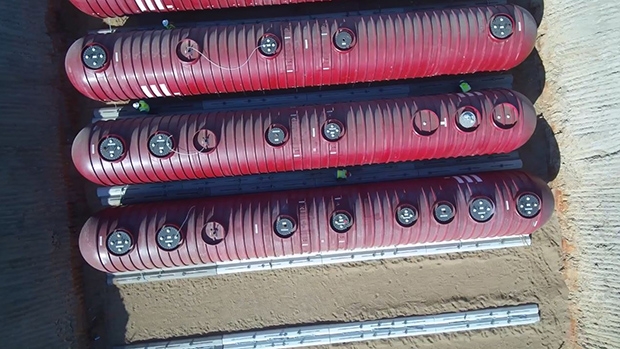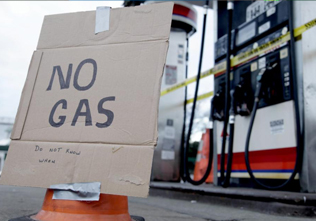Tom Tietjen, VP of Fuel Markets, ZCL | Xerxes, and writing consultant Ann K. Ryan, Keen Consultants US, describe changes in the fuel storage market, the risks of corrosion with new fuels, new forms of monitoring and the growth of fiberglass in their piece for PetrolPlaza.

Since the early 1980s, fiberglass underground storage tanks (USTs) have gained considerable market share in North America, most significantly in the retail fuel market. In the last 35 years, this market share has increased from less than 10 percent to approximately 75 percent of new tanks being installed. Today, 29 out of the 30 largest fuel marketers in the US now primarily specify and purchase fiberglass tanks. In Canada, fuel retailers choose fiberglass tanks at an even higher rate than in the US.
Several factors have led to the growing number of fiberglass reinforced plastic (FRP) tanks in the ground. In addition to the growth of new convenience stores in general, the following factors are also indicators of both past and future growth in the demand for fiberglass USTs:
- Aging population of single-wall tanks currently in the ground
- Growing awareness of internal tank corrosion due to fuel composition
- Private UST-insurance companies’ willingness to insure older tanks
- Recognition of the benefits of true continuous monitoring of USTs and of new sump testing requirements
Ageing population of tanks
By the 1980s, it was common knowledge that bare steel tanks were corroding, resulting in environmental damage due to fuel releases. Federal regulations were passed requiring UL-listed fiberglass, composite or cathodically protected steel tanks with approved corrosion protection. The major concern at the time was external corrosion.
Tank owners were given 10 years (a deadline of 1998) to replace noncompliant tanks. This led to the permanent removal of well over a million fuel tanks and the installation of thousands of new corrosion-protected tanks, many of them fiberglass. Between 1984 and September 2018, the EPA reports that more than 1.8 million fuel tanks were removed or taken out of service.
Today, the EPA estimates approximately 550,000 regulated USTs are operational compared to its original estimate of 2.1 million tanks at the introduction of federal regulations in 1988. In part, this reduction in the total number of fuel tanks is because they generally have larger capacities than previously, and some have multiple compartments to accommodate different grades and types of fuels. The warranties on many of the tanks installed in this 10-year regulatory window are due to expire between 2018 and 2028, which garnered the attention of many in the industry.
The PEI Journal’s 3RD Quarter 2018 cover article drew attention to this concern. Certain US states have used tank age as a condition for replacement. In other cases, many North American fuel retailers are replacing single-wall tanks with double-wall fiberglass tanks as part of a planned risk-mitigation program.
Internal corrosion with new fuels
In the last 20-30 years, underground fuel storage in North America has been impacted by the following changes in the components of liquid fuels and fuel additives:
- Lead additives have been removed from retail fuels.
- Methyl tertiary butyl ether (MTBE) – once a common fuel additive to reduce vehicle air emissions – is now banned.
- Ethanol is widely used/mandated as a fuel additive.
- Sulfur content has been substantially lowered in diesel fuel, with ultra-low sulfur diesel (ULSD) being the common product now used.
- Biodiesel blends have become increasingly popular.
This change in fuels means that the concern about corrosion has shifted from a focus on external tank corrosion to internal tank corrosion. While most USTs containing motor fuel have certain levels of water in them, the use of ethanol in gasoline significantly increases the probability of water buildup in tank bottoms. Ethanol, found in virtually all gasoline sold in North America today, has a propensity to attract water in fuel mixtures, leaving "water bottoms" that accumulate over time in USTs.
This water buildup provides a breeding ground for corrosive microbial activity, known as "microbial influenced corrosion" (MIC). With MIC, the potential for corrosion failure of metallic fueling components increases.
EPA, industry groups and individual companies are in the process of studying the extent and root cause of this corrosion problem, with a particular focus on ULSD-related corrosion. As answers and solutions are considered, there is no question that today’s biofuels can cause aggressive corrosion to metallic tanks, fueling components inside a tank and tank sumps. Awareness of this throughout the industry continues to grow. EPA’s 2015 paper “Corrosion in Underground Storage Tanks (USTs) Storing Ultra-Low Sulfur Diesel (ULSD)” drew attention to the scope of the problem.
One industry trade association, the Steel Tank Institute (STI), initiated a multiyear campaign to educate steel tank owners about the necessity for ongoing tank maintenance to include the removal of water bottoms. Some steel tank warranties have been revised, addressing the failure to remove water from tank bottoms. In many cases, the term of warranty coverage for steel tanks has been reduced from 30 to 10 years.
Another solution is to have tanks and other fuel system components fabricated of materials that are inherently resistant to corrosion. The industry has seen the introduction of corrosion-resistant materials from a number of leading fuel equipment manufacturers for various equipment components traditionally made of carbon steel. Composite materials, including fiberglass, are one of the materials providing corrosion resistance to fueling equipment solutions.
Fiberglass tanks and pipe have been tested extensively for their corrosion resistance in fuel applications. In fact, fiberglass had a proven track record in preventing equipment corrosion long before today’s biofuels became popular. Test data and extensive marketplace use confirms that fiberglass is the superior choice of material when metallic corrosion and the costly and time-consuming need for routine maintenance of tanks is a concern.
North America’s largest and most well-known retail fuel marketers, as well as many small marketers, use noncorrosive fiberglass tanks and pipe to provide protection to the environment and peace of mind for the tank owner in view of this growing concern.
Financial responsibility for USTs
Another trend contributing to the replacement of aging single-wall tanks and the growth of new double-wall fiberglass tanks in the marketplace is the impact of private insurance availability to meet the regulatory requirements for tank owner financial responsibility. Federal law requires that tank owners prove that they have sufficient financial resources to cover site cleanup, environmental damage and third-party compensation in the event of product release into the environment. This is commonly known as financial responsibility.
Tank owners have three ways to demonstrate financial responsibility:
- Self-insurance
- Private insurance policies
- State funds (now available in 36 US states).
Many tank owners choose to secure insurance company policies even if they have state fund coverage available to them, given the broader coverage available in private policies.
A recent trend is that insurance companies are increasingly reluctant to renew policies for aging tanks (typically 25-30+ years of age), and those that do often charge high premium rates, making it cost-prohibitive for many tank owners. For those owners, replacing single-wall tanks is a better long-term financial choice.

True continuous monitoring and sump testing
Aside from regulations, a growing number of tank owners have come to recognize the value and protection that continuous hydrostatic monitoring provides for all site conditions, whether dry or groundwater conditions are present. Tank manufacturer members of the Fiberglass Tank and Pipe Institute report that approximately two-thirds of their tank customers choose hydrostatic monitoring when purchasing new tanks.
Hydrostatic continuous monitoring, unique to fiberglass tanks for more than 25 years, has also proven to be the most popular choice for monitoring of double-wall sumps. Dealing with leaking containment sumps can be expensive.
Revised US federal tank regulations introduced in 2015 require tank containment sumps to be periodically tested for watertight integrity. An exemption to this periodic testing is double-wall sumps with continuous monitoring. This has led to an increased interest in hydrostatically monitored double-wall fiberglass containment sumps.
The new sump testing requirements are causing some tank owners to replace their entire fuel systems with state-of-the-art secondarily contained equipment, given the investment necessary to solve the leaking sump issues.
Continuous monitoring of tanks and sumps is also a requirement in some states. Even when not mandated, it is a sensible way to avoid the costly, routine testing of secondary containment systems.
Growth of fiberglass
There is widespread concern and uncertainty in the marketplace about how extensive corrosion damage in metallic tank and fueling components is (and will become) – and how to prevent it. Increasingly, this is seen as a significant reason to choose corrosion-resistant fiberglass materials for fuel system components (whether tanks, pipe, tank sumps or under dispenser sumps) and to use continuous hydrostatic monitoring for leak detection.
More and more North American fuel marketers see the many values of choosing corrosion-resistant products UL-listed for today’s variety of bio-fuels. Choosing state-of-the-art secondarily contained products from the industry’s leading fiberglass equipment manufacturers gives them the peace of mind they are looking for.
* Tom Tietjen, the vice president of ZCL | Xerxes fuel markets, provided subject-matter expertise for this article based on his 35+ years with the company. ZCL | Xerxes is one of the largest manufacturer of fiberglass underground storage tanks.
* Ann K. Ryan has worked on marketing, sales and engineering projects at ZCL | Xerxes for close to 30 years.
SOURCE : Petrolplaza.com






